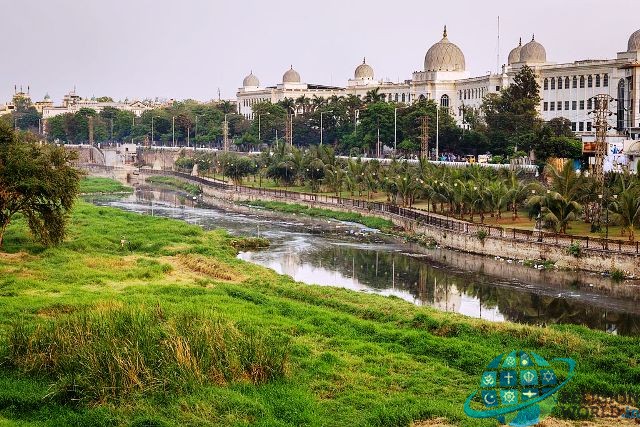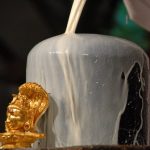Yet another Urban River is Musi River, the tributary of Krishna River, is the lifeline for Hyderabad. The city which has turned into metropolitan city of India is completely dependent on Musi was water source. Both the important water reservoirs are constructed over Musi. But unfortunately Musi is not loved by people of Hyderabad and today is meager drain that flows in between the city.
Religion World will look at the rivers that call for immediate attention, because they have been polluted beyond repair. But the effort is to look at the river, its history, its use and how it was been brought to the state it is now. Our effort to write about these rivers is to enlighten the readers that they need attention and they can once again turn into lifeline for human race in their part. Today we bring, river flowing through Hyderabad, Musi River.
Must Read : #KnowYourRiver : Noyyal River
Musi River:
Musi River is the Telangana River which flows on Deccan Plateau. Known as Muchukunda River in earlier days has now become Musi. The happening city of Hyderabad is on the bank of this river. The city is divided between the old city and the new city by this river. The Purana Pul is the oldest bridge over the river in Hyderabad. Himayat Sagar and Osman Sagar are the two dams which are the water reservoirs and the main water sources for Hyderabad.

Origin & Flow
Musi rises in the Ananthagiri hill in Ranga Reddy district and flows into the Krishna at Vedapally in Nalgonda district. Vikarabad is the birthplace of Musi. The Purana Pul was constructed in 1579 A.D. during the reign of Ibrahim Qutub Shah. Until the early decades of 20th century, the Musi River was the cause of flood devastation in Hyderabad. On 28 September 1908, Musi River was the reason for the devastating floods in Hyderabad.
As it flows through Hyderabad, it turns into a giant sewer, filled with garbage and industrial waste from the city. Years of neglect have earned it the notoriety of being named one of the most polluted rivers in the country. Thanks to civic failure to address this, the Musi has kept up this dubious distinction for the third consecutive year in a row.
Lover Story around Musi
Muhammad Quli Qutub Shah, before he became the fifth ruler of Golconda, was in love with a local dancer named Bhagmati. She lived in a cottage in Chichlam village, located on the southern bank of Musi.
As a prince, he travelled across Musi- which linked Golconda and Chichlam, often braving the flood waters to meet his lady love on the other side of the river.
Quli Qutub Shah’s father couldn’t bear his son risking his life while crossing the dangerous river to meet his beloved. So, he built a bridge across the river which exists today and is known as Purana Pul (old bridge). There are many new bridges.
After his wedding to Bhagmati, Quli Qutub Shah was crowned the emperor. As a gift to his bride, he renamed Chichlam as Bhaganagar.
When the fort of Golconda faced severe shortage of water and other resources, the emperor shifted the capital to Bhaganagar.
By then Bhagmati had converted to Islam and had got the title as Hyder Mahal. Once again in honour of his wife, the emperor renamed Bhaganagar as Hyderabad, according to history.
The Infamous Musi Floods
The calm river flowing through Hyderabad wasn’t all about nature’s bounty and love stories, but it was the reason of misery every time it was in a spate. As per records there were over 112 floods in Hyderabad since 1572 AD and the worst, according to history, over 15,000 people were killed and an equal number rendered homeless after the Musi floods of 1908. To cope with the enormity of devastation the then ruler, sixth Nizam Mir Hahboob Ali Khan, opened the gates of his palace to people of Hyderabad and saved many lives.
On the positive side, the floods were a lesson for the rulers and that was where the modern era of development took roots. Abdallah Ahmed Bin Mahfooz submitted his report on October 1, 1909, with recommendations on preventing a recurrence of floods and improving civic amenities. Nizam VII constituted a City Improve Trust in 1912. He built a flood control system on the river. A dam was built in 1920 across the river, ten miles (16 km) upstream from the city called Osman Sagar. In 1927 another reservoir was built on Esi (tributary of Musi) and named Himayat Sagar. These lakes prevented the flooding of the River Musi and are major drinking water sources for Hyderabad city.
The rulers drew a roadmap and elaborate plans were made for development of Hyderbad, making it a planned city, with sufficient precautionary measures to tackle natural disasters.
Ecological issues

A 2012 study on the Impact of the pollution on health and economic conditions of downstream villages found that the pollution gave rise to several major problems including a high incidence of diseases such as arthritis, diarrheic, skin allergies, stomach pain, malaria, food poisoning, eye diseases, paediatric problems and jaundices.
Today, the river has become a dumping site for domestic and industrial waste because of lack of planning and impartial urbanization. It was once the mighty river which has become a dumping giant now. The river is dying a slow death affecting the health of the citizens. As it passes through Hyderabad, it converts into a giant sewer. Years of neglect has made the river to come among the most polluted rivers in the country. Crores ofRupeess has been spent for treating it but no progress has been seen.
Despit being a part of National River Conservation Plan (NRCP) for the past six years, 2 projects undertaken by the Hyderabad Metropolitan Development Authority (HMDA) and many other projects no significant change has been come into notice. The industrial waste contaminates the gound water. The Common Effluent Treatment Plants (CETPs) were set up to take care of this, but no progress has been observed in the decaying condition of Musi River.
While Hyderabad owes its birth to Musi, despite losing its charm to urban development, it is a suggestive of the city’s glorious past. And this is the reason, the Telangana government is now keen on beautifying it at any cost.
Must Read : #KnowYourRivers : Cooum River
Must Read : #KnowYOurRiver : Krishna River









